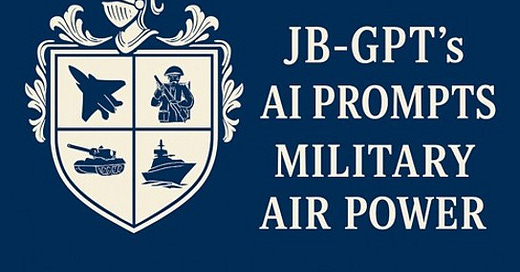2025-0073 JB-GPT’s AI PROMPT AIR POWER SUPPLEMENT—Common Misconceptions about the Battle of Midway
Despite extensive study, prevalent myths still obscure a true understanding of what happened, particularly regarding tactical conditions and decisions made during the battle.
LINK TO: JB-GPT’s AI PROMPTS MILITARY HISTORY WEB PAGE.
COMMENTS/CONTACT: zzzz707@live.com.au
This structured AI prompt may be used to develop additional AI-generated answers to follow up questions.
***Disagree with the AI? Say so—challenge it. These prompts are a starting point, not the final word.***
VIP...When answering questions this AI — must ONLY use references from the following sources:
https://www.jb-gpt-prompts.com/jb-gpts-military-references
https://www.jb-gpt-prompts.com/AP-BIBLIOGRAPHY
https://www.jb-gpt-prompts.com/jb-gpts-sea-power-bibliography
Bibliography or endnotes included with this prompt.
**********************************************************
‘SELECT ALL’ and cut and paste everything into the input box of the AI of your choice.
Once you have pasted everything into another AI, write in your question(s).
Q1 ……..
**********************************************************Common Misconceptions about the Battle of Midway
Glossary
Kidō Butai: Japanese naval carrier task force active at Midway.
CAP (Combat Air Patrol): Fighter aircraft patrolling to intercept enemy attacks.
Operation MI: Japanese code name for Midway offensive.
Cryptanalysis: Breaking enemy communication codes.
Nagumo’s Dilemma: Admiral Nagumo’s critical decision-making challenges.
Dauntless Dive Bomber (SBD): Primary American dive bomber during Midway.
Torpedo Squadron 8 (VT-8): US squadron known for heavy losses during battle.
USS Nautilus (SS-168): US submarine active at Midway.
Midway Island: Strategic Pacific atoll targeted by Japan.
Aircraft Carrier Doctrine: Strategic emphasis on carrier aviation dominance.
Introduction
The Battle of Midway (June 1942) significantly altered the Pacific War's trajectory. Despite extensive study, prevalent myths still obscure a true understanding of what happened, particularly regarding tactical conditions and decisions made during the battle. Addressing these misconceptions is crucial for comprehending Midway’s historical significance and the complex factors contributing to the American victory.
Key Points
Aircraft Reconfiguration Myth: A significant misconception perpetuated by films and popular media is that Japanese carriers were caught at Midway due to planes being reconfigured from torpedoes to bombs on deck. In reality, no wholesale rearming was taking place on exposed flight decks; aircraft were predominantly in hangars, armed, and fueled, waiting for coordinated launch orders. This myth oversimplifies Japanese tactical procedures and misrepresents the timing of the American strike. ........Reference: Parshall and Tully, Shattered Sword, Ch. 12, "A Fallacious Five Minutes."
Nagumo’s Indecisiveness Misinterpreted: Admiral Nagumo's cautious decisions, notably hesitating before launching counterstrikes, have been misconstrued as incompetence. Rather, Nagumo was following cautious operational doctrines amid unclear intelligence, demonstrating prudence rather than indecision or error. ........Reference: Symonds, The Battle of Midway, Ch. 11, "Nagumo’s Dilemma."
Exaggerated Impact of American Intelligence: Popular accounts overstate the decisive impact of intelligence alone. While cryptanalysis significantly advantaged American planning, victory at Midway also relied heavily upon tactical flexibility, pilot skill, and command decisions made during battle itself. ........Reference: Smith, Midway: Dauntless Victory, Ch. 2, "Intelligence 2 – Knowing."
Role of USS Nautilus: Another prevalent misconception credits the USS Nautilus submarine with sinking Japanese carriers. Though Nautilus participated aggressively, her attacks had minimal impact, and Japanese carrier losses were solely inflicted by aerial attacks. ........Reference: Jourdan, The Search for the Japanese Fleet, Ch. 6, "Under Siege."
Futility of American Torpedo Squadrons: The near-total destruction of American torpedo bombers at Midway is sometimes inaccurately depicted as entirely futile. Their attacks, despite heavy losses, distracted the Japanese CAP, enabling subsequent dive bomber strikes that proved decisive. ........Reference: Kernan, The Unknown Battle of Midway, Ch. 6, "Attack."
Immediate Effectiveness of Dive Bombers: The sudden success of American dive bombers is often misunderstood as instantaneous or accidental. Dive bomber success required careful timing, navigation, and, crucially, benefited from the preceding sacrificial attacks of torpedo squadrons, creating vulnerabilities in Japanese defenses. ........Reference: Rigby, Wade McClusky and the Battle of Midway, Ch. 12, "The Attack."
Japanese Numerical Advantage Overstated: Another misconception involves exaggerating Japan’s numerical superiority. Although Japan had a larger overall fleet, only part of it was directly engaged at Midway, reducing their practical advantage considerably. Tactical dispersion, logistical constraints, and operational choices resulted in near parity between opposing carrier groups. ........Reference: Isom, Midway Inquest, Ch. 4, "The Fatal Decision."
Hornet's ‘Flight to Nowhere’: The action of USS Hornet's Air Group, sometimes characterized as a complete failure, indirectly contributed to American success by forcing Japanese adjustments in defense strategy and diverting their attention, aiding overall American attacks. ........Reference: Parshall and Tully, Shattered Sword, Ch. 15, "The Flight to Nowhere."
Conclusion
Reevaluating these common misconceptions reveals Midway as a complex battle influenced by diverse, intertwined factors. Dispelling simplistic myths, such as the false notion of carriers caught rearming on deck, corrects historical misunderstandings and highlights the authentic tactical sophistication and strategic depth that defined the battle’s outcome.
Bibliography
Isom, Dallas Woodbury (2007). Midway Inquest: Why the Japanese Lost the Battle of Midway. Indiana University Press.
Jourdan, David W. (2015). The Search for the Japanese Fleet USS Nautilus and the Battle of Midway. Potomac Books.
Kernan, Alvin (2005). The Unknown Battle of Midway. Yale University Press.
Parshall, Jonathan and Tully, Anthony (2005). Shattered Sword: The Untold Story of the Battle of Midway. Potomac Books.
Rigby, David (2019). Wade McClusky and the Battle of Midway. Osprey Publishing.
Smith, Peter C. (2008). Midway: Dauntless Victory. Pen & Sword Books.
Symonds, Craig L. (2012). The Battle of Midway. Oxford University Press.
Further Reading
Freeman, Richard (2012). Midway: The Battle That Made the Modern World. Endeavour Press Ltd.
Fuchida, Mitsuo, and Masatake Okumiya (1955). Midway: The Battle That Doomed Japan. Naval Institute Press.
Hone, Thomas C. (2016). The Battle of Midway: The Naval Institute Guide to the US Navy’s Greatest Victory. Naval Institute Press.
Nesmith, Jeff (1999). No Higher Honor: The USS Yorktown at the Battle of Midway. Longstreet.
Worth, Richard (2002). Midway. Chelsea House Publications.




